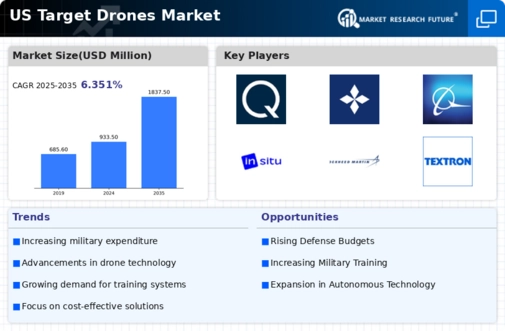Increased Military Investment
The target drones market is seeing a surge in military investment due to the need for advanced training and simulation capabilities. The U.S. Department of Defense has allocated substantial budgets for the procurement of target drones, with expenditures reaching approximately $1.5 billion in 2025. This investment is aimed at enhancing the effectiveness of military training exercises, allowing for realistic scenarios that improve combat readiness. As military operations evolve, the demand for versatile and reliable target drones is likely to grow, indicating a robust future for the target drones market. Furthermore, the integration of advanced technologies such as artificial intelligence and autonomous systems into these drones is expected to further enhance their operational capabilities, making them indispensable in modern warfare.
Rising Focus on Training and Simulation
The target drones market is recognized for its role in training and simulation, especially in military contexts. As armed forces seek to enhance their training methodologies, the use of target drones for live-fire exercises and tactical simulations is becoming more prevalent. In 2025, it is estimated that approximately 40% of military training budgets will be allocated to drone-based training solutions. This shift reflects a broader trend towards realistic training environments that prepare personnel for real-world scenarios. The ability of target drones to mimic enemy aircraft and provide dynamic targets is invaluable for honing skills and improving operational readiness. Consequently, the emphasis on training and simulation is likely to drive sustained growth in the target drones market, as military organizations invest in advanced solutions to meet their training needs.
Strategic Partnerships and Collaborations
The target drones market is characterized by strategic partnerships and collaborations among key stakeholders. Defense contractors, technology firms, and research institutions are joining forces to develop innovative drone solutions that meet the evolving needs of military and defense sectors. These collaborations often focus on integrating advanced technologies such as artificial intelligence, machine learning, and enhanced sensor systems into target drones. In 2025, it is projected that partnerships will account for over 25% of new product developments in the target drones market. This collaborative approach not only accelerates innovation but also enhances the competitive landscape, as companies leverage each other's strengths to deliver superior products. As the demand for sophisticated training and operational solutions grows, these strategic alliances are likely to play a crucial role in shaping the future of the target drones market.
Technological Innovations in Drone Design
The target drones market is seeing rapid technological innovations that reshape drone design and functionality. Recent advancements in materials science and engineering have led to the development of lighter, more durable drones that can withstand harsh operational conditions. For instance, the introduction of composite materials has reduced the weight of target drones by up to 30%, enhancing their maneuverability and flight duration. Additionally, the incorporation of advanced avionics and control systems is improving the precision and reliability of these drones. As these innovations continue to emerge, they are likely to attract more investment and interest from military and defense sectors, further propelling the growth of the target drones market. The ability to integrate cutting-edge technologies such as machine learning and real-time data analytics into drone operations is also expected to enhance training effectiveness.
Growing Demand for Unmanned Aerial Systems
The target drones market is benefiting from the increasing demand for unmanned aerial systems (UAS) across various sectors. As industries recognize the advantages of UAS for surveillance, reconnaissance, and training, the market is projected to expand significantly. In 2025, the U.S. UAS market is estimated to reach $10 billion, with a notable portion attributed to target drones. This growth is fueled by advancements in drone technology, which enhance performance and reliability. Additionally, the versatility of target drones in simulating enemy aircraft and providing realistic training scenarios is appealing to military and defense organizations. The ongoing development of UAS regulations is also likely to support this trend, as it paves the way for broader adoption and integration of target drones into various operational frameworks.






















Leave a Comment